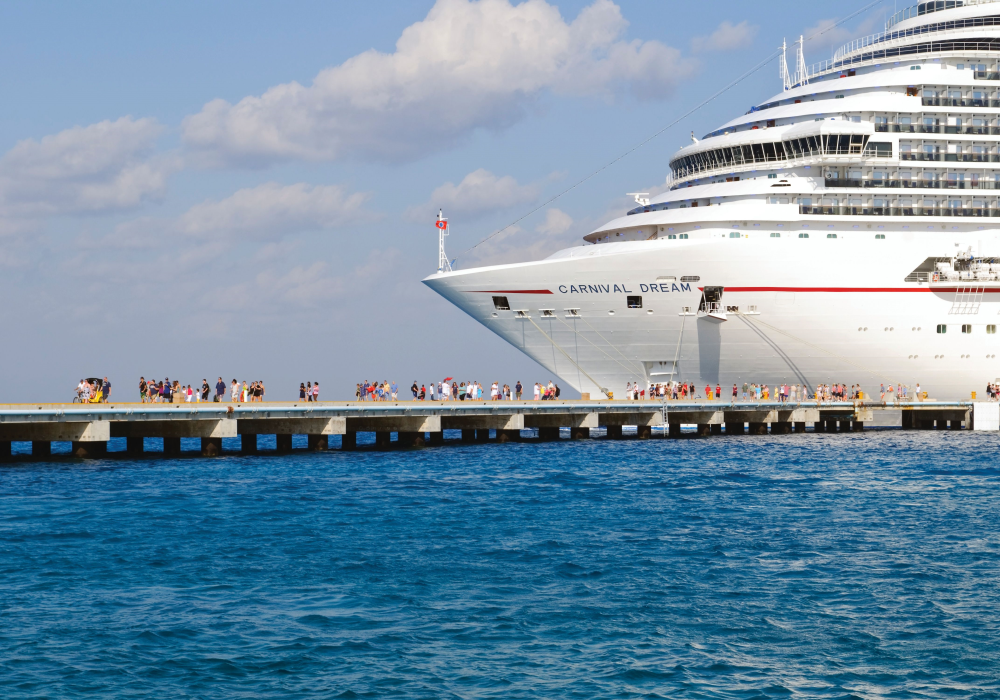COZUMEL, Mexico – The lights often start to twinkle on the horizon before the sun even rises on this Caribbean island. They signal the start of a daily parade of cruise ships that brings swarms of tourists and their money. They’re an economic lifeline for many of the island’s residents, and yet they leave plenty of environmental damage behind.
Thousands of tourists disembark from the cruise ships in the morning, flooding the 48-kilometre-long island during the day. And an estimated 20% of them go snorkelling to explore the beautiful coral reef just off the coast. This coral makes up part of the Mesoamerican Reef, which stretches from just north of Cancun all the way down to Honduras and is the second-largest in the world behind the Great Barrier Reef. Overtourism is just one of the threats that the ecosystems on these reefs face, along with the warming waters of climate change and a rise in deadly coral diseases.
The growing number of visitors to Cozumel has pitted the long-term health of the coral against those whose businesses depend on reef tourism. But that is beginning to change on the island. And it’s been changing in other parts of the world, too, thanks to marine biologists and environmental organizations working to make the coral reef tourism industry sustainable.
“We’re really starting to see the tourism sector as a key ally in conservation, because we all rely on the same goal, which is to have healthy coral reefs,” says Elizabeth Shaver, the coral conservation program manager for The Nature Conservancy’s Caribbean division.
While reef conservation efforts have been ongoing in Cozumel for years, the COVID-19 pandemic gave tour operators the chance to reexamine their approach. The pandemic was rough on the island’s tourism-centred economy. In the early months, cruise ships from Disney, Royal Caribbean, Carnival and Norwegian evaporated, the island’s waterfront became a ghost town, and the coral reefs got a break from snorkelling crowds. But this downtime also gave tour operators the chance to train staff – those who were able to keep them – in sustainable best practices (such as avoiding all contact with the reef and using proper fin techniques to avoid disturbing the coral).
While Cozumel’s cruise ship economy doesn’t evoke images of ecotourism, more tourists want to know that their visit hasn’t done (too much) harm to the planet, pushing tour operators to step up. “I think that was a very important ingredient in that conversation,” says Javier Pizaña-Alonso, a program manager for the Coral Reef Alliance who oversees the training of Cozumel tour operators about best practices so they can properly educate the tourists they bring to the reef.
Pizaña-Alonso says that the licensed operators who visit the marine protected area that covers the local reefs have all been taught these best practices, but there are still many “pirate” operators who operate without the proper permissions or training and with little enforcement. There are around 225 boats of different sizes that have permits to go into the marine protected area, but Pizaña-Alonso says he often sees up to 500 boats in a day in the park.
A harder conversation than getting tour operators on board with sustainability is with cruise ship companies and governments that want to maximize the number of cruise ship tourists that visit the island. Pizaña-Alonso says he has been in discussions with government officials about limiting the number of people cruise-ship companies bring to Cozumel, arguing that they could charge fewer people more money and make the same amount of revenue. “I don’t want to have 100 people pay me $1. I’d rather have 20 people that pay me $5. Let’s change that,” he says.

The issue isn’t so much that this type of tourism exists in Cozumel. Pizaña-Alonso says that reef tourism can happen sustainably, but the core issue is volume. In 2022, more than 1,100 cruise ships visited Cozumel, bringing almost three million visitors. More than three million cruise ship tourists are expected to visit this year. A proposed new pier that has caused controversy for years would add to that total. The federal government approved plans for a fourth pier, which has attracted protests from residents and environmentalists, before a judge suspended its construction last year, leaving it in limbo.
“The governments at these destinations are pushing for volume, and we gauge the tourism performance based on the people you bring to your destination rather than income for the local community. So, we’re trying to change the metrics that governments use for success,” Pizaña-Alonso says.
A way forward
Partnerships are also underway elsewhere in the Caribbean, between conservationists and the tourism industry, to conserve coral.
Last year, The Nature Conservancy teamed up with the Caribbean Hotel & Tourism Association and the United Nations Environment Programme to create a document called A Guide to Coral Reef Restoration for the Tourism Sector to help tourism operators overcome some of the barriers to being more sustainable. In the past, Shaver says, restoration efforts have been left mostly to scientists and coral reef managers, but the tourism industry has become increasingly involved in recent years. That’s partly due to the realization that coral is critically important for the GDP of many small countries.
In the Caribbean alone, reef-associated tourism generates US$8 billion a year from more than 11 million visitors, according to The Nature Conservancy. Conservationists are increasingly seeing the tourism sector as a valuable ally that can help spread the message of how important coral reefs are.
“Tourism infrastructure absolutely relies on reefs,” says Shaver. “The more the tourism industry sees the critical importance of reefs to maintaining their businesses, the more we’ll be able to engage together and the more impactful our conservation work will be.”
Pizaña-Alonso has plans to travel to different destinations within the Mesoamerican Reef area to teach around 12 people in each destination to become sustainability trainers for tour operators in those places. Last year, he and his team helped formalize a group called a destination management organization (DMO) for Cozumel, which brings together conservationists, local business associations and representatives from local government to protect the natural environment from the impacts of tourism. The Coral Reef Alliance is also helping to set up DMOs in Roatán, Honduras, and Belize – two other major cruise ship destinations where reef tourism is a central part of their economies.
Progress down under
In Australia, tour operators have been heavily involved in efforts to propagate coral at the Great Barrier Reef. Unprecedented back-to-back mass bleaching events in 2016 and 2017 impacted two-thirds of the coral in the Great Barrier Reef, threatening the collapse of ecosystems that are so central to Australian tourism. It proved to be a turning point for the tourism industry and the government in Australia in how they viewed the immediacy of the loss of coral.
Since 2018, scientists have been partnering with the tourism industry there in what’s called the Coral Nurture Program, in which tour operators are attaching corals onto the reef. Researchers are hoping that through the project they’ll be able to improve the efficiency of planting and growing coral and learn where it’s most likely to survive. The project (which has planted more than 80,000 corals) has already had some success, with upwards of 10% more coral cover in some areas.
“It’s really brought together the tourism industry [and conservationists] towards a common purpose,” says Emma Camp, a coral reef expert with the University of Technology Sydney who runs the program with two colleagues.
Camp says that while the actions of some bad tour operators tend to get a lot of attention, there are a lot of tour operators that are trying to do the right thing by teaching tourists about how to visit coral reefs without causing damage, as well as about the other threats the reefs face. And some of the information they are relaying back to scientists is invaluable, as they know these areas better than anyone.
“They’re the early warning system,” Camp says. “They feed knowledge back to the government and scientists. When stress events occur … it’s the tourism operators on the Great Barrier Reef that are likely to see it because they go out day after day after day.”
Taking a break
Another strategy authorities have tried in Cozumel to preserve coral is more drastic: shutting off access to parts of the reef for a few months at a time. This started in 2019, but Pizaña-Alonso says the project hasn’t produced enough data yet to prove whether it works, as coral grows very slowly. He has been more focused on limiting the number of people coming to the reefs than shutting off access entirely.
After all, when the cruise ships leave Cozumel at the end of the day, conservationists hope that the tourists who have visited the coral leave having learned a lesson not only about its beauty, importance and value, but also about the peril it faces. They hope they’ll spread the message that we’re losing this part of the natural world. And that we’ll continue losing it, as well as the jobs and economic growth it brings, if we don’t act fast.







